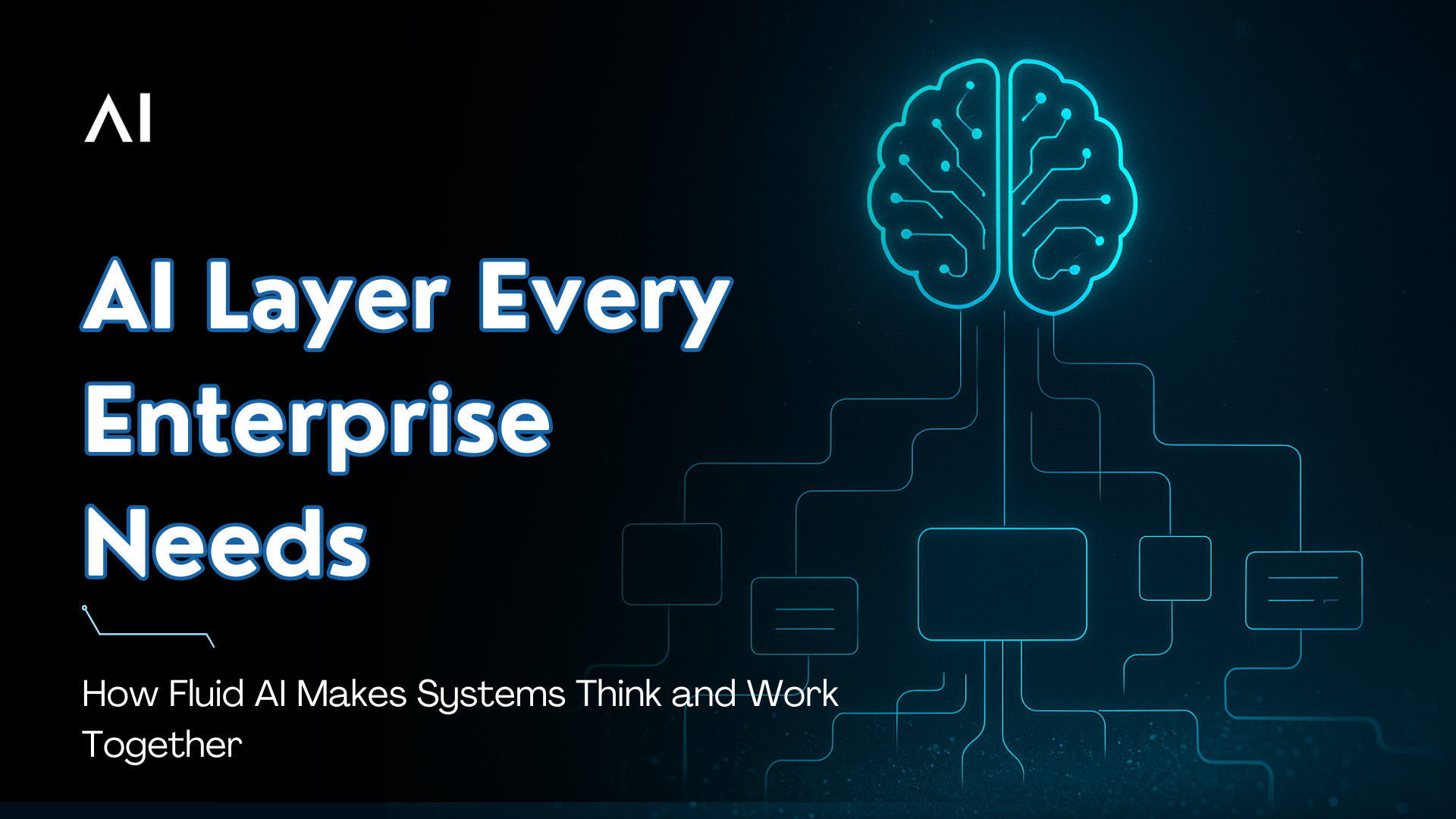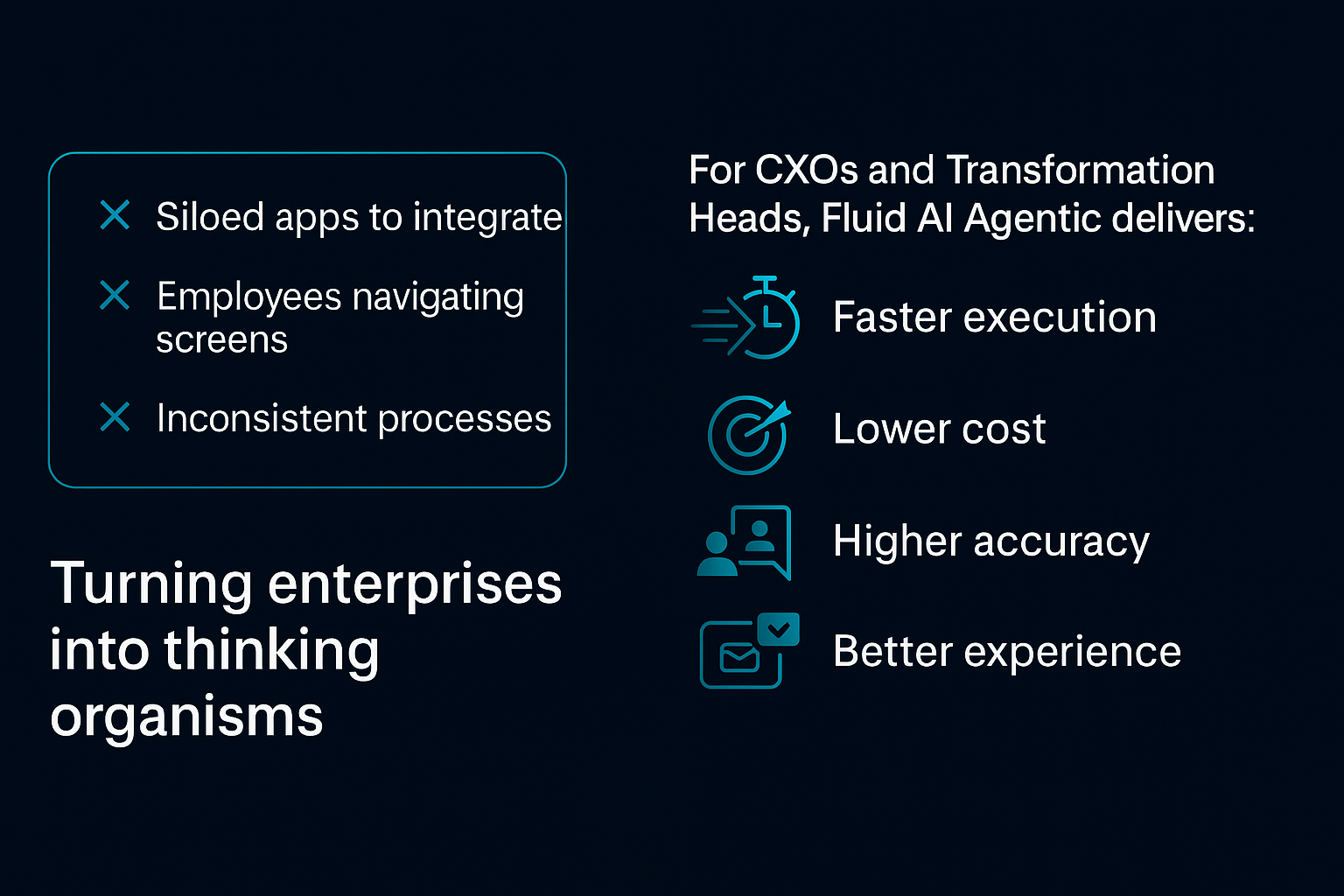Join our WhatsApp Community
AI-powered WhatsApp community for insights, support, and real-time collaboration.
Fluid AI’s Agentic platform replaces apps with one intelligence layer that connects systems, reasons with memory, and executes workflows autonomously.

| Why is AI important in the banking sector? | The shift from traditional in-person banking to online and mobile platforms has increased customer demand for instant, personalized service. |
| AI Virtual Assistants in Focus: | Banks are investing in AI-driven virtual assistants to create hyper-personalised, real-time solutions that improve customer experiences. |
| What is the top challenge of using AI in banking? | Inefficiencies like higher Average Handling Time (AHT), lack of real-time data, and limited personalization hinder existing customer service strategies. |
| Limits of Traditional Automation: | Automated systems need more nuanced queries, making them less effective for high-value customers with complex needs. |
| What are the benefits of AI chatbots in Banking? | AI virtual assistants enhance efficiency, reduce operational costs, and empower CSRs by handling repetitive tasks and offering personalized interactions. |
| Future Outlook of AI-enabled Virtual Assistants: | AI will transform the role of CSRs into more strategic, relationship-focused positions while continuing to elevate the customer experience in banking. |
Enterprises have digitized every process — and in doing so, buried their people under dozens of dashboards and portals.
Every day, employees jump between CRMs, ticketing tools, ERPs, chat systems, spreadsheets, and compliance trackers.
They’re not working smarter; they’re translating — moving data from one system to another, summarizing reports, updating cases, and sending follow-ups.
That “digital friction” is now one of the biggest hidden costs in enterprise operations.
Fluid AI’s Agentic platform was designed to end this.
It doesn’t create another tool for humans to manage. It creates an intelligence layer that manages the tools themselves.

Instead of opening ten different systems, imagine saying:
“Close all loan applications that are fully verified and send the disbursement notices.”
You don’t touch a system.
The AI agent fetches the data from the core banking platform, validates eligibility, generates the communication, and triggers the action.
That’s not a chatbot.
That’s Agentic AI — AI that can remember context, reason over workflows, and act across your enterprise stack.
Fluid AI’s platform was built specifically to power this kind of autonomy. It serves as the orchestration brain that sits above your existing software, taking in intent (from voice, chat, or email) and outputting completed actions.
Fluid AI’s Agentic platform is a complete cognitive stack built for enterprise-grade reasoning and execution.
Here’s what that means in practice:
Fluid integrates directly with existing systems — CRMs, ERPs, email servers, ticketing tools, and industry-specific platforms like Core Banking, Insurance Policy Administration, or SAP.
No rip-and-replace. The platform connects via APIs, IMAP, SIP, or data pipelines and builds a unified context graph around them.
At the heart of Fluid’s Agentic platform is a persistent memory and reasoning engine.
It stores organizational knowledge, past interactions, and contextual cues — allowing the agent to “remember” what happened last time, learn from it, and act accordingly.
This means if a customer asks a follow-up question tomorrow, the AI doesn’t start from scratch; it continues the conversation where it left off.
Instead of static automation, Fluid uses Agentic RAG (Retrieval-Augmented Generation with reasoning) — where the system not only retrieves information but plans and executes the next steps.
For example:
Each step is reasoned, verified, and executed autonomously.
This is how Fluid moves from text generation to task completion — bridging analytics, planning, and operations.
A similar idea is expanded in Agentic AI Delivers Executive-Ready Insights on Autopilot.
Complex workflows aren’t handled by one model; they’re coordinated between multiple agents.
Planner agents break a task into goals.
Retriever agents gather data.
Executor agents act through APIs or system commands.
Supervisor agents audit actions for compliance.
This multi-agent orchestration lets Fluid handle layered, real-world enterprise processes — from loan disbursal and dispute resolution to KYC verification and collections.
For an overview of real use cases across industries, check out the Agentic AI Use Case Playbook.
Fluid AI doesn’t just run in chat windows. It operates wherever your business communicates.
All three channels share one memory layer — so the AI that spoke to a customer yesterday can respond today via email or chat with full context intact.
For end-to-end details on deploying calling agents on your numbers, start here: https://www.fluid.ai/channel-autonomous-ai-voice-and-calling-agents
That’s what makes it Agentic: continuous cognition across modalities.
Traditional automation ends at task completion.
Fluid’s agents work until the business goal is achieved — whether that’s resolving a complaint, approving a form, sending a notification, or updating a ledger.
You don’t need dashboards to manage these tasks; you just monitor performance.
The platform removes the cognitive overhead of clicking, searching, and switching — turning human interaction into human supervision.
This is what we call the Great Interface Collapse: the moment when software stops needing a user interface because intelligence takes over the interaction layer.
Fluid AI isn’t a research prototype. It’s built for the complexity, governance, and compliance demands of large organizations — particularly in sectors like Banking, Insurance, Oil & Gas, and Manufacturing.
Depending on data sovereignty and regulatory needs, Fluid AI can be deployed fully on-premise or within private clouds.
This flexibility makes it viable for BFSI and government clients where data never leaves controlled infrastructure.
Every action taken by an agent is logged, auditable, and reversible.
Agents operate under bounded autonomy — they can only act within defined compliance and policy limits.
That’s why Fluid’s systems are deployed even in highly regulated environments with RBI, ISO, and SOC-2 governance frameworks.
Fluid’s agents work in multiple languages and dynamically select the most efficient model (large or small) depending on the task — balancing reasoning quality with compute cost.
From one workflow to hundreds, new agents can be added modularly, each trained on different contexts but coordinated by a shared reasoning graph.
You’re not scaling people; you’re scaling intelligence.
For CXOs and transformation heads, Fluid AI’s Agentic platform changes how you think about enterprise software:

Instead, you gain:
Fluid AI effectively turns your enterprise into a thinking organism — where every system, process, and interaction is coordinated by agents that understand your business logic.
The enterprise stack is evolving:
People → Agentic Layer → Systems → Data.
The new middle layer — the Agentic Layer — is what Fluid AI already builds and deploys.
It’s not a chatbot, not an integration hub, and not an automation script.
It’s the reasoning brain of the modern enterprise — connecting, contextualizing, and executing seamlessly across everything you own.
When that layer takes over, the need for traditional interfaces fades.
You don’t log into ten apps; you state your goal once.
The AI does the rest.
That’s not the future of work — that’s Fluid AI’s present.
A platform where systems think, agents act, and intelligence becomes infrastructure.
When a customer reconnects, the AI remembers the relationship, not just the query — a capability explored in When Your Bank Starts to Remember You: Where Agentic AI Turns Data Into Foresight.
Fluid AI is an AI company based in Mumbai. We help organizations kickstart their AI journey. If you’re seeking a solution for your organization to enhance customer support, boost employee productivity and make the most of your organization’s data, look no further.
Take the first step on this exciting journey by booking a Free Discovery Call with us today and let us help you make your organization future-ready and unlock the full potential of AI for your organization.

AI-powered WhatsApp community for insights, support, and real-time collaboration.
.webp)
.webp)

Join leading businesses using the
Agentic AI Platform to drive efficiency, innovation, and growth.
AI-powered WhatsApp community for insights, support, and real-time collaboration.